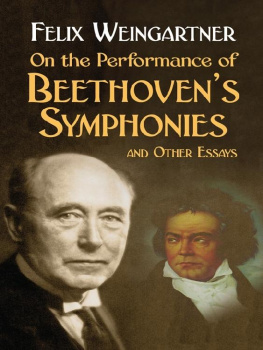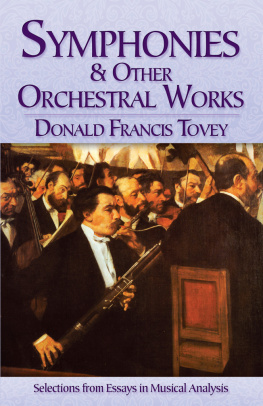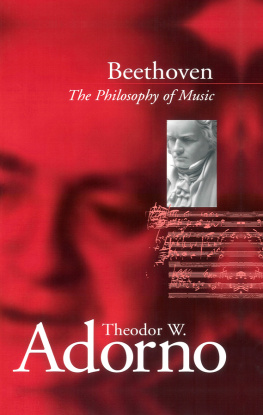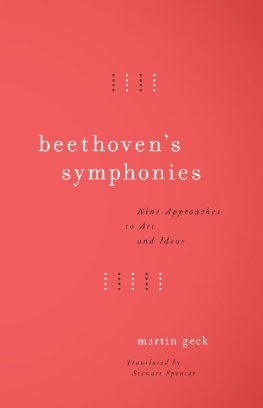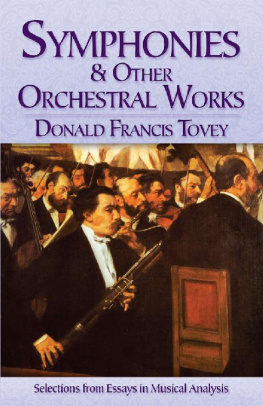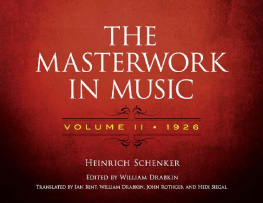
Copyright
Copyright 1969 by Dover Publications, Inc.
All rights reserved.
Bibliographical Note
The present volume, first published by Dover Publications, Inc. in 1969 as Weingartner on Music and Conducting and reprinted in 2004 under the present title, contains the following material:
The unabridged and unaltered text of On Conducting (Ernest Newmans translation of the third German edition of Weingartners ber das Dirigieren ), originally published by Breitkopf & Hrtel, Leipzig (second edition, 1925). All passages altered or added by Weingartner in the fourth German edition have been newly translated for the Dover edition and appear in an Appendix to On Conducting.
On the Performance of Beethovens Symphonies (Jessie Croslands translation of the first German edition of Weingartners Ratschlge fr Auffhrungen der Symphonien Beethovens ), originally published by Breitkopf & Hrtel, Leipzig, in 1907. This text has been corrected and revised to conform entirely with the third German edition; all such alterations have been prepared specially for the Dover edition.
The Symphony Since Beethoven, a completely new unabridged translation of the fourth German edition of Weingartners Die Symphonie nach Beethoven, prepared specially for the Dover edition by H. M. Schott. Mr. Schott has also furnished several new notes and a new Translators Preface.
See the Publishers Note on the facing page for the bibliography of the various German editions and for more specific information on the preparation of the present volume.
9780486174761
Manufactured in the United States of America
Dover Publications, Inc., 31 East 2nd Street, Mineola, N.Y 11501
Publishers Note
The present volume contains English translations of three important literary works of the conductor Felix Weingartner (18631942). The translations given here take fully into account the revisions undertaken by the author at various times.
On Conducting first appeared in German (as ber das Dirigieren ) in 1895. A second, unchanged German edition was published the following year. The translation by Ernest Newman (second edition, 1925) which is the basis of the present text was made from the heavily revised third German edition of 1905. In order to show the reader the definitive form of the work, as established by the fourth German edition of 1913 (a fifth German edition, 1920, introduced no changes), while still preserving Newmans text intact, we have added in an Appendix to On Conducting new translations (specially prepared for this edition) of material rewritten or added by Weingartner in the fourth German edition, and we have placed within brackets those passages in Newmans text which correspond to passages omitted in the fourth German edition.
On the Performance of Beethovens Symphonies first appeared in German in 1906 with the title Ratschlge fr Auffhrungen der Symphonien Beethovens. A very lightly altered second edition was published in 1916. When the third edition appeared in 1928 (with a few more changes), it had become Volume ( Band ) I, Beethoven, of a series known as Ratschlge fr Auffhrungen klassischer Symphonien (the series now included a volume on Schubert and Schumann and one on Mozart, both of which had also originally been published separately). The only English translation of this work on Beethoven, by Jessie Crosland, appeared in 1907, and was thus prepared from the first German edition. The present text is basically the Crosland translation, but we have incorporated directly into it new translations of those sections rewritten or added in later editions by Weingartner and we have completely omitted what he later omitted, so that the reader will have before him here a full translation of the definitive form of the work. In addition, we have replaced Weingartners system of references to pages in the complete Breitkopf & Hrtel Beethoven with references to bars numbered consecutively throughout each movement, since many more readers today will have access to scores numbered consecutively than to the Breitkopf edition. Finally, we have reviewed the entire text of this Crosland translation, overhauling the peculiar punctuation and styling of the original edition, correcting the numerous typographical and other errors and occasionally making improvements in the diction.
The Symphony Since Beethoven first appeared in German (as Die Symphonie nach Beethoven ) in 1897; second edition ca . 1901. The third edition, 1909, was a thorough revision amounting practically to a new book, while the fourth and final edition of 1926 introduced even more changes. Two independent English translations already in existence were both prepared from the now altogether obsolete second German edition. Therefore, the present volume includes an all new translation, written specially for Dover by H. M. Schott, of the complete German fourth edition. Mr. Schott has added a few explanatory notes of his own, as well as a very welcome Translators Preface to which we refer the reader for further information on Weingartner and his era.
Table of Contents
ON CONDUCTING
Translated by Ernest Newman
Translators Note
Herr Weingartners On Conducting first appeared in the Neue Deutsche Rundschau, Berlin, and then in book form in 1895. A second edition, not differing from the first, appeared in 1896. The third edition, from which the present translation is made, was issued in 1905; it omits so much that was in the first edition, and contains so much that did not appear there, as to be practically an entirely new treatise. I have added a few notes in order to make a point here and there clearer to the English reader.
E. N.
On Conducting
Under the same title as that of the present volume, Richard Wagner published in 1869 his well-known brochure, to be in trusty hands; nor did he anticipate concert productions of them with large orchestras and choruses.]
How much Mozart considered the question of interpretation is to be seen in the careful way he has marked his works (especially his latest), and from many passages in his letters. It is not improbable that in Mannheim he heard for the first time an orchestra that could really play crescendo and diminuendo. Even our best orchestras of to-day need to be constantly told that the increase and decrease of tone is to be done evenly and gradually, not suddenly; and the difficulty of doing this increases with the number of bars over which these variations in volume have to be extended. Diminuendo signifies forte, crescendo signifies piano , said Bulow. This is only a seeming contradiction, since to play forte at the beginning of a crescendo, and piano at the beginning of a diminuendo, really means the negation of crescendo and diminuendo. We know that not only Mozart, but Weber, Mendelssohn and Spohr were excellent conductors, and that each of them, from his own artistic standpoint, fought energetically against abuses and errors of taste. How Wagner did this is shown among other things in the book of his I have mentioned. This, however, with all its perfect outspokenness, seems quite mild when we read the flaming words with which Berlioz opens his treatise on The theory of the conductors art. He says:
Singers have often been reproached with being the most dangerous of the factors concerned in the production of music; but, I think, unjustly. The most formidable intermediary is in my opinion the conductor. A bad singer can spoil only his own part, while an incompetent or malicious conductor can spoil everything. The composer must indeed count himself fortunate when the conductor into whose hands he has fallen is not both incompetent and malicious; for against the destructive influence of such a man nothing can avail. The most excellent orchestra is crippled by him; the finest singers are perplexed and exhausted; there is no longer any ardour or precision in the rendering. Under conducting of this kind the composers finest audacities become mere oddities; enthusiasm is killed; inspiration comes precipitately to earth; the angels wings are clipped; a genius is made to look like an eccentric or a madman; the godlike statue is thrown from its pedestal and dragged in the mud. The worst of it is that the public, no matter how good its musical education may be, is not in a position, at the first performance of a new work, to detect the mutilations, stupidities, errors and sins against art that such a conductor has on his conscience.
Next page
